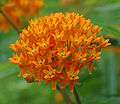Asclepias tuberosa
Asclepias tuberosa, the butterfly weed, is a species of milkweed native to eastern and southwestern[2] North America. It is commonly known as butterfly weed because of the butterflies that are attracted to the plant by its color and its copious production of nectar. It is also a larval food plant of the queen and monarch butterflies, as well as the dogbane tiger moth, milkweed tussock moth, and the unexpected cycnia[3]. Hummingbirds, bees and other insects are also attracted.[4] It is not a preferred host plant of the monarch butterfly but caterpillars can be reared on it successfully. However, it is one of the very lowest Asclepias species in cardenolide content, making it a poor source of protection from bird predation and parasite virulence.
| Asclepias tuberosa | |
|---|---|
 | |
| Scientific classification | |
| Kingdom: | Plantae |
| Clade: | Tracheophytes |
| Clade: | Angiosperms |
| Clade: | Eudicots |
| Clade: | Asterids |
| Order: | Gentianales |
| Family: | Apocynaceae |
| Genus: | Asclepias |
| Species: | A. tuberosa |
| Binomial name | |
| Asclepias tuberosa | |
| Synonyms[1] | |
| |
Description
It is a perennial plant growing to 0.3–1 metre (1 ft 0 in–3 ft 3 in) tall, with clustered orange or yellow flowers from early summer to early autumn. The leaves are spirally arranged, lanceolate, 5–12 cm long, and 2–3 cm broad.
Some wild plants have been reported to have orange flowers that are very reddish. It is uncertain if this is due to soil mineral content, ecotype genetic differentiation, or both. A cultivar, "Hello Yellow", typically has more yellowish flowers than ordinary examples of this plant.
Distribution and habitat
This plant favors dry, sand or gravel soil, but has also been reported on stream margins. It requires full sun.
Identification
The plant looks similar to the lanceolate milkweed (Asclepias lanceolata), but is uniquely identified by the larger number of flowers, and the hairy stems that are not milky when broken. It is most commonly found in fields with dry soil.
Propagation
Most easily propagated by seed. Sown outdoors after frost, a plant will flower and produce seed in the third year. Difficult to transplant once established.[5][6] In cultivation in the greenhouse, plants can easily be grown from seed to flowering in as little as three to six months.
Subspecies
- Asclepias tuberosa subsp. interior – (Central United States, Ontario and Quebec[7])
- Asclepias tuberosa subsp. rolfsii – Rolfs milkweed (Southeastern United States)
- Asclepias tuberosa subsp. tuberosa – (Eastern United States)
Common names
Common names include butterfly weed,[8] Canada root, chieger flower,[8] chiggerflower, fluxroot, Indian paintbrush, Indian posy, orange milkweed, orange root,[9] orange Swallow-wort, pleurisy root,[8] silky swallow-wort, tuber root, yellow milkweed, white-root, windroot, butterfly love, butterflyweed, and butterfly milkweed.[10]
Uses
Native Americans and European pioneers used the boiled roots to treat diarrhea and respiratory illnesses.[11] The young seed pods were used as food after being boiled in several changes of water.[11] The seed pod down was spun and used to make candle wicks.[11]
Use of the plant is contraindicated in pregnancy, during lactation or with infants due to the small amount of cardiac glycosides.[12]
Gallery
 Entire plant from the ground to the flower
Entire plant from the ground to the flower- Young stems during spring
 A young leaf
A young leaf An emerging flower head
An emerging flower head- Closeup of the hairy stems
- Closeup of unopened buds
 Flower head
Flower head Closeup showing unopened, opening, and fully opened flower buds
Closeup showing unopened, opening, and fully opened flower buds Orange flowers
Orange flowers Red-striped orange flowers
Red-striped orange flowers Yellow flowers
Yellow flowers Seedpod
Seedpod
Footnotes
- "Asclepias tuberosa". World Checklist of Selected Plant Families (WCSP). Royal Botanic Gardens, Kew – via The Plant List.
- http://bonap.net/TDC/
- The Xerces Society (2016), Gardening for Butterflies: How You Can Attract and Protect Beautiful, Beneficial Insects, Timber Press.
- Schillo, Rebecca (2011). Cummings, Nina (ed.). "Native Landscaping Takes Root in Chicago". In the Field. The Field Museum: 13.
- Loewer, Peter 'Native Perennials For the Southeast' Cool Springs Press. Nashville, Tenn. 2005 ISBN 1-59186-121-7
- Druse, Ken 'Making More Plants The Science, Art, and Joy of Propagation' Abrams. New York, NY. 2012 ISBN 0-517-70787-X
- Species profile on VASCAN. Retrieved on February 21, 2018.
- "Asclepias tuberosa". Germplasm Resources Information Network (GRIN). Agricultural Research Service (ARS), United States Department of Agriculture (USDA). Retrieved 17 December 2017.
- anonymous (2008). "Featured Native Plant: Butterfly Weed" (PDF). Wild Ones: Native Plants, Natural Landscapes. 6 (4). Archived from the original (PDF) on 2014-08-14. Retrieved 2013-06-11.
- Dickinson, T.; Metsger, D.; Bull, J.; & Dickinson, R. (2004) ROM Field Guide to Wildflowers of Ontario. Toronto:Royal Ontario Museum, p. 138.
- "Butterfly Weed (Asclepias tuberosa)". tpwd.texas.gov. Retrieved 2019-03-06.
- "Asclepias tuberosa". Native Plant Database. Lady Bird Johnson Wildflower Center, University of Texas at Austin.
References
- Peterson, Roger Tory; Margaret McKenny (1968). A Field Guide to Wildflowers of Northeastern and North-central North America. Boston: Houghton Mifflin Company. ISBN 978-0-395-18325-0.
- Photo of a J.J. Audubon Plate Clay-Colored Sparrow perched atop Asclepias tuberosa
External links
| Wikimedia Commons has media related to Asclepias tuberosa. |
| Wikispecies has information related to Asclepias tuberosa |
| The Wikibook Horticulture has a page on the topic of: Asclepias tuberosa |
- Butterfly weed brief information and pictures
- Missouri Botanical Garden Asclepias tuberosa
